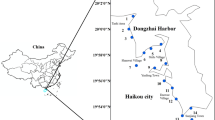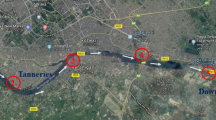Abstract
Cyanide (CN) pollution was reported in the downstream areas of Watut and Markham Rivers due to effluent discharges from gold mining and processing activities of Hidden Valley mines in Morobe province of Papua New Guinea. We monitored free cyanide levels in Watut and Markham River waters randomly three times in years for 2 years (2012 and 2013). Besides, a short-term static laboratory study was conducted to evaluate the potential of river sediment to attenuate externally added cyanide, with and without the presence of biochar material. Results indicated that the free cyanide content ranged between 0.17 and 1.32 μg L−1 in the river waters. The free cyanide content were found to be significantly (p < 0.05) greater in June (0.87 μg L−1) and May (0.77 μg L−1) months of 2012 and 2013, respectively, than the rest of the months. However, free cyanide levels in all four monitoring sites across three sampling intervals were lower than 0.20 mg L−1 which is the maximum contaminant level (MCL) permitted according to US Environmental Protection Agency. Under laboratory conditions, the biochar-impregnated sediment showed ∼3 times more attenuation capacity for cyanide than non-amended sediment, thus indicating possibility of using biochar to cleanse cyanide from spills or other sources of pollution.


Similar content being viewed by others
References
Abdalla, O. E., Suliman, F. O., Al-ajmi, H., Al-hosni, T., & Rollinson, H. (2010). Cyanide from gold mining and its effect on groundwater in arid areas, Yanqul mine of Oman. Environmental Earth Sciences, 60(4), 885–892.
ASTM International. (2009). Standard test method for determination of free cyanide in water and wastewater by micro diffusion, D4282, ASTM Annual Book of Standards, 11.01. Philadelphia: American Society for Testing and Materials.
Bell, F., & Donelly, L. (2006). Mining and its impact on the environment (p. 560). Madison Avenue, New York: Taylor and Francis.
Botz, M. M., & Mudder, T. I. (1995). Recovery and re-use. Chapter 3. The cyanide monograph. London: Mining Journal Books.
Bucheli, T., & Gustafsson, Ö. (2001). Ubiquitous observations of enhanced solid affinities for aromatic organochlorines in field situations. Environmental Toxicology and Chemistry, 20, 1450–1456.
Bucheli, T., & Gustafsson, Ö. (2003). Soot sorption of non-ortho and ortho substituted PCBs. Chemosphere, 53, 515–522.
Cheng, C. H., Lehmann, J., Thies, J. E., Burton, S. D., & Engelhard, M. H. (2006). Oxidation of black carbon by biotic and abiotic processes. Organic Geochemistry, 37, 1477–1488.
Cherryholmes, K. L., Cornils, W. J., McDonal, D. B., & Splinter, R. C. (1985). Biological degradation of complex iron cyanides in natural aquatic systems. In R. D. Cardwell, R. Purdy, & R. C. Bahner (Eds.), Aquatic toxicology and hazard assessment: seventh symposium, ASTM STP 854 (pp. 502–511). Philadelphia: American Society for Testing and Materials.
Chiou, C. T., & Kile, D. E. (1998). Deviations from sorption linearity on soils of polar and nonpolar organic compounds at low relative concentrations. Environmental Science and Technology, 32, 338–343.
Eisler, R., & Weimeyer, S. N. (2004). Cyanide hazards to plants and animals from gold mining and related water issues. Reviews of Environmental Contamination and Toxicology, 183, 21–54.
Griffiths, S. R., Donato, D. B., Coulson, G., & Lumsden, L. F. (2014). High level of activity of bats at gold mining water bodies: implications for compliance with the international cyanide management code. Environmental Science and Pollution Research, 21(12), 7263–7275.
Hill, E. F., & Henry, P. F. P. (1996). Cyanide. In A. Fairbrother, S. N. Locke, & G. L. Hoff (Eds.), Noninfectious diseases of wildlife (2nd ed., pp. 99–107). Ames: Iowa State University Press.
Hiller, E., Fargasova, A., Zemanova, L., & Bartal, M. (2007). Influence of wheat ash on the MCPA immobilization in agricultural soils. Bulletin of Environmental Contamination and Toxicology, 78, 345–348.
Huertas, M. J., Saez, L. P., Roldan, M. P., Luque-Almagro, V. M., Martinez-Luque, M., Blasco, R., Castillo, F., Moreno-Vivian, C., & Garcia-Garcia, I. (2010). Alkaline cyanide degradation by Pseudomonas pseudoalcaligenes CECT5344 in a batch reactor. Influence of pH. Journal of Hazardous Materials, 179(1–3), 72–78.
Lotter, N., 2006. Cyanide volatilisation from gold leaching operations and tailing storage facilities. Thesis submitted to University of Pretoria, Republic of South Africa.
Lottermoser, B. (2010). Mine wastes: characterization, treatment and environmental impacts. Heidelberg: Springer.
McKinnon, E. (2002). The environmental effects of mining waste disposal at Lihir Gold Mine, Papua New Guinea. Journal of Rural and Remote Environmental Health, 1(2), 40–50.
MMJV (Morobe Mining Joint Ventures). (2012). Available at http://www.morobejv.com/environment/index.htm. Accessed on 12 Nov 2012.
Murray, L., Friedel, R., Suter, G., Penman, J., Watt, J., & Jitno, H. (2010). Hidden Valley—design and performance of the first tailings dam in Highland Papua New Guinea in the proceedings of Canadian Dam Association 2010 Annual Conference held at Niagara Falls (pp. 1–11) ON, Canada.
Ndur, S. A., & Amegbey, N. A. (2013). Surface water quality at Boete Slimes Dam, AngloGold Ashanti Ltd, Obuasi. International Journal of Environmental Monitoring and Analysis., 1(2), 53–57.
Noller, B. N., & Saulep, G. (2000). Evaluation of cleanup following loss of cyanide in flight to Tolukuma (Papua New Guinea) gold mine. National Research Centre for Environmental Toxicology. Queensland: The University of Queensland.
Obiri, S., Dodoo, D. K., Okai-Sam, F., & Essumang, D. K. (2007). Determination of free cyanide and total cyanide concentrations in surface and underground waters in Bogoso and its surrounding areas in Ghana. Bulletin of Chemical Society of Ethiopia, 21, 213–220.
Osei, B. A., & Ahmed, R. M. (2013). Evaluation of an integrated approach involving chemical and biological processes for the detoxification of gold tailings effluent in Ghana. West African Journal of Applied Ecology, 21, 145–156.
Ouyang, L., Yu, L., & Zhang, R. (2014). Effects of amendment of different biochars on soil carbon mineralisation and sequestration. Soil Research, 52, 46–54.
PNG Mine Watch. (2012). Watut communities find dead fish floating in their river. Available at: https://ramumine.wordpress.com/tag/watut-river/page/5/. Accessed 20 Mar 2012.
Rajashekhar Rao, B. K., & Siddaramappa, R. (2008). Evaluation of soil quality parameters in a tropical paddy soil amended with rice residues and tree litters. European Journal of Soil Biology, 44, 334–340.
Robin, W.W. (2013). Biochars production and utilization for enhancing sweet potato productivity, MSc Thesis, PNG University of Technology, Papua New Guinea.
Sohi, S., Lopez-Capel, E., Krull, E., & Bol, R. (2009). Biochar, climate change and soil: a review to guide future research, CSIRO Land and Water Science Report 05/09, Australia.
Sohi, S. P., Krull, E., Lopez-Capel, E., & Bol, R. (2010). A review of biochar and its use and function in soil. Advances in Agronomy, 105, 47–82.
Sparks, D. L. (1996). Methods of soil analysis part 3—chemical methods, SSSA book series no. 5 (p. 1390). WI: SSSA Madison.
Thomas, L. C., & Chamberlin, G. S. (1974). Chemical analytical methods. Salisbury: AOAE International suite.
Thuries, L., Pansu, M., Feller, C., Hermann, P., & Remy, C. (2001). Kinetics of added organic matter decomposition in a Mediterranean sandy soil. Soil Biology and Biochemistry, 33, 997–1010.
USEPA (US Environmental Protection Agency). (1985). Ambient water quality criteria for cyanide-1984. Washington: Office of Water Regulations and Standards Criteria and Standard Division.
USEPA (US Environmental Protection Agency). (2002). National primary drinking water standards. Washington: Office of Research and Development.
Zheng, A., Dzombak, D. A., Luthy, R. G., Sawyer, B., Lazoaskas, W., Tata, P., Delaney, M. F., Zilitinkevitch, L., Sabroski, J. R., Swartting, R. S., Drop, S. M., & Flaherty, J. M. (2003). Evaluation and testing of analytical methods for cyanide species in municipal and industrial contaminated waters. Environmental Science and Technology, 37, 107–115.
Acknowledgments
The authors wish to thank Mr. David Willy, CEO of NATSL, and technicians at NATSL for providing logistic support and lab facilities to conduct this work. The assistance of Dr. S. Sailesh, Department of Surveying and Land Studies, in the production of location map is gratefully appreciated.
Author information
Authors and Affiliations
Corresponding author
Rights and permissions
About this article
Cite this article
Sawaraba, I., Rao, B.K.R. Monitoring of river water for free cyanide pollution from mining activity in Papua New Guinea and attenuation of cyanide by biochar. Environ Monit Assess 187, 4181 (2015). https://doi.org/10.1007/s10661-014-4181-z
Received:
Accepted:
Published:
DOI: https://doi.org/10.1007/s10661-014-4181-z




